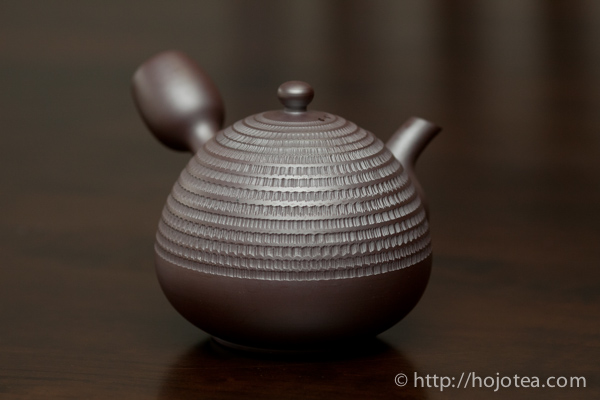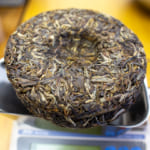- HOME >
- Featured Articles
Are not you choosing teapot just by color?

The colour and texture of the teapot varies a lot, where the same clay could turn red, purple or black based on just the firing technique. In addition, the use of different firing techniques not only changes the colour of clay, but also the taste and flavour of the tea when it is brewed. Therefore, when selecting a teapot, it is important to consider the effects it brings to a tea rather than the colour of the teapot.
Oxidation and Reduction Firing
Mainly, there are 2 different firing techniques, which are oxidation and reduction firing. Oxidation firing is a process where complete and perfect combustion occurs when sufficient oxygen is supplied, converting all the fuel into carbon dioxide (CO2) and water (H2O). However, in reduction firing (also called incomplete combustion), the oxygen supply is insufficient for a complete combustion. However, hydrogen is still oxidized to water, but carbon monoxide is formed instead of carbon dioxide. Solid particles (particulates) are also released which contains carbon (C) and are seen as soot or smoke.
The oxidation fire exhibits blue flames while the reduction fire exhibits orange flames.
Allow me to illustrate more about the flame that both oxidation and reduction firing produces. For instance, let’s take our home cooking gas stove as an example, and lid it up; blue flames will ignite out from the burner. Thus, this flame is called the oxidation flame (sufficient oxygen supply). On the contrary, a reduction flame (insufficient oxygen supply) is the fire on a candle or an open fire which is of orange to red color.

The houhin on the left is a Mumyoi reduction clay, the center is a Tokoname oxidation clay and the one on the right is a Mumyoi oxidation clay.
The oxidation fire oxidizes the minerals
The oxidation fire oxidizes the clay as it releases a lot of heated oxygen during combustion. With oxidation fire, the minerals in a teapot are oxidized. For instance, iron is a mineral contained in clay and when a clay is rich in iron, after heated, it gets oxidized (oxidation of iron) and turns red. Another common exemplar, when a cast iron kettle or a frying pan is heated on a gas stove, the bottom part tends to turn reddish in color. This is also due to the oxidation of iron.
The reduction fire reduces minerals
On the contrary, a reduction fire releases carbon monoxide (CO) and hydrogen gas (H) as the by-products. These molecules are unstable and therefore looking for other free atoms like oxygen (O) to bind with and achieve stability. Thus, the availability of oxygen in the clay allows binding of molecules to occur, producing an end-product of carbon dioxide (CO2) and water (H2O). Hence, when a clay that is rich in iron, it may appears in different colours ranging from blue to black as a result of reduction [Fe2O3 + CO ===> 2FeO + CO2 (FeO, ferrous iron oxide)]. This is the mechanism minerals get reduced during combustion.
The firing methods of clay affect the taste of tea
The different firing methods not only affect the color of the clay, but also the taste and flavor of a tea. For my up-coming lineups of clays, such as Mumyoi, Nosaka and the new Kobiwako clay, I have produced them both with oxidation and reduction fire. They are all very colorful and beautiful. But, I strongly suggest that you choose a teapot deliberately not just based on its color, but the effect it brings to the tea. Allow me to share the basic conception in taste based on oxidation and reduction fire.
Body
Oxidation Fire > Reduction Fire
After Taste
Reduction Fire > Oxidation Fire
Do you prefer body or after taste?
The above idea in taste is applicable for most kinds of clay. For example, the Banko teapot is a typical reduction fired teapot. It produces less body than the tea brewed in a glass teapot, but increases the after taste of the tea. With a lighter body, the flavor also becomes lighter. Since it is of this character, a reduction fired teapot is usually suitable to brew Green tea and ripe Pu-erh tea. However, for fermented teas such as an oolong or black tea, oxidation fired clay is generally more suitable as it gives more body. As a result, the flavor would spread wider in our mouth. Nonetheless, it is pretty subjective on whether one would appreciate more after taste or body. I have noticed many cases where my customers would select a reduction clay as they would prefer nothing but a strong after taste even if it sacrifices the body. After all, it is based on one’s preference to use an oxidation or reduction clay. In any case, it is essential to understand the property and conception in taste.
Two different reduction fired clays
There are two different types of reduction firing techniques commonly used by teapot artists in Japan. The first one is using reduction fire throughout the firing process, while the second method starts with oxidation firing and subsequently re-fires with reduction fire. For instance, Banko teapot is fired with reduction fire throughout the firing process, whereas the reduction Nosaka and Mumyoi clay wares are fired using the second method. Because of the two-steps firing method, the inner part of the clay will be red in color even if the teapot looks black. Based on my experiment, the effect to the taste of tea is more or less the same between both the firing methods.

Shigaraki clay teapot by Masaki Tachi. Although this teapot looks beige in color, it has undergone reduction firing. For some clays, it is hard to judge based on the color whether it is reduction or oxidation
Body and After Taste
After taste means softness, smoothness, long lasting, clarity, lingering feeling.
Body means heaviness, weight, width, richness.
Related Articles
How to get the latest update on HOJO?
1. Follow Twitter, 2. Click "Like" on Facebook, and 3. Subscribe in newsletter. You can have the latest tea news from HOJO.
 Subscribe the Newsletter to enjoy the privileges
Subscribe the Newsletter to enjoy the privileges- You may receive a free sample upon purchase, or you may have the priority to purchase special products. So please remember to subscribe our newsletter as well as the social network.
- New Arrival of Akitsu Mumyoi and Nosaka Rough Clay Teapot
- A wide selection of teaware by Watanabe Tozo, a Sado-based artist of Mumyoi-yaki, has just arrived. This time, …
- Mang Fei Ripe Pu-erh Tea 2023 – Small-Batch Production from a Renowned Region
- Mang Fei Ripe Pu-erh Tea 2023 is now available. This is one of the highest-quality ripe pu-erh teas among our …
NEW ARTICLES
 Development of Firewood Roasted Hojicha Using Naturally Grown Tea from Yunnan
Development of Firewood Roasted Hojicha Using Naturally Grown Tea from Yunnan- We are currently staying in Yunnan Province for tea production. As the season nears its end, tea trees with pa …
 Exploring the Food Culture of Yunnan: Where Minority and Sichuan Cuisines Meet
Exploring the Food Culture of Yunnan: Where Minority and Sichuan Cuisines Meet- We are currently staying long-term in Yunnan Province for spring tea production. On rainy days or when there i …
 New Arrival of Akitsu Mumyoi and Nosaka Rough Clay Teapot
New Arrival of Akitsu Mumyoi and Nosaka Rough Clay Teapot- A wide selection of teaware by Watanabe Tozo, a Sado-based artist of Mumyoi-yaki, has just arrived. This time, …
 Managing Yunnan White Tea — Insights from the Field
Managing Yunnan White Tea — Insights from the Field- Since March 25, we have been in Yunnan Province, fully engaged in the production of white tea. In this column, …
 Mang Fei Ripe Pu-erh Tea 2023 – Small-Batch Production from a Renowned Region
Mang Fei Ripe Pu-erh Tea 2023 – Small-Batch Production from a Renowned Region- Mang Fei Ripe Pu-erh Tea 2023 is now available. This is one of the highest-quality ripe pu-erh teas among our …
 Yunnan Tea Trends 2025: Insights from the Fields
Yunnan Tea Trends 2025: Insights from the Fields- Since March 25, we have been in Yunnan Province. We will stay here until May to conduct tea production, packin …
 Why Do Some Teas Taste Astringent? Exploring the Causes and Mechanisms of Astringency
Why Do Some Teas Taste Astringent? Exploring the Causes and Mechanisms of Astringency- Tea can range from having no noticeable astringency to possessing a very strong one. What causes this astringe …
 The Impact of Heat Sources on Tea Flavor
The Impact of Heat Sources on Tea Flavor- It is widely recognized that the material of a kettle plays an important role in shaping the taste of water fo …
 New Release of Tang Li Shan Ripe Pu-erh Tea 2023
New Release of Tang Li Shan Ripe Pu-erh Tea 2023- We have released the 2023 edition of Tang Li Shan Ripe Pu-erh Tea. Tang Li Shan refers to a mountain located o …
 The New Release of Dong Shan Raw Pu-erh Tea 2023 and Jasmine Silver Needle
The New Release of Dong Shan Raw Pu-erh Tea 2023 and Jasmine Silver Needle- We have released Dong Shan Raw Pu-erh Tea 2023 and Jasmine Silver Needle. Dong Shan Raw Pu-erh Tea 2023 We hav …
Category
- New Arrival at HOJO Online Shop
- Featured Articles
- Newsletter
- Types of Tea
- Origin of Tea
- Teapot and Tea Equipment
- Tea Column
- How to enjoy tea
- Tea Processing
- How to choose quality tea
- Tea constituents and functional effect
- Safety of Tea
- Foods
- Tea Business Operation
- Hobby and Outdoor Activity
- Ranking of Tea
- Video
- FAQ
- Media Release
Profile

- AKIRA HOJO
- I invite you to experience my tea selections.I was born in Nagano, Japan. In university, I studied agricultural chemistry, and I have the master degree in food science. I worked in Japanese food industry for 10 years. I involved in R&D, QC and QA. As a factory manager, I implemented ISO9000 series and managed the factory.
- The Art of Tea Magazine
- We posted the article on “The Art of Tea Magazine No.9, the magazine is published in Taiwan. We featured …
- New Straits Times
- The Malaysian National Newspaper, New Straits Times featured HOJO Tea on 17-Oct-2007.
Shop Info

Address:Lot No. T-215, 3rd Floor, The Gardens Mall, Mid Valley City, Lingkaran Syed Putra, 59200 Kuala Lumpur
Tel: +603-2287-4537
Business Hour: 10am to 10pm


















